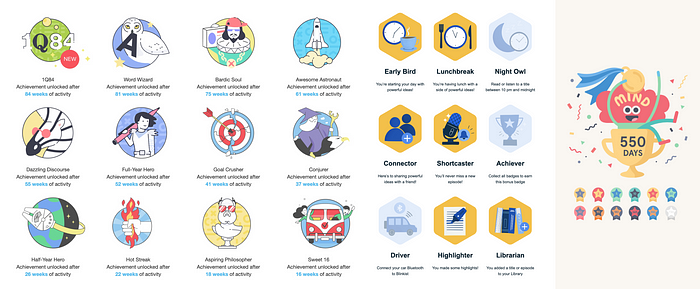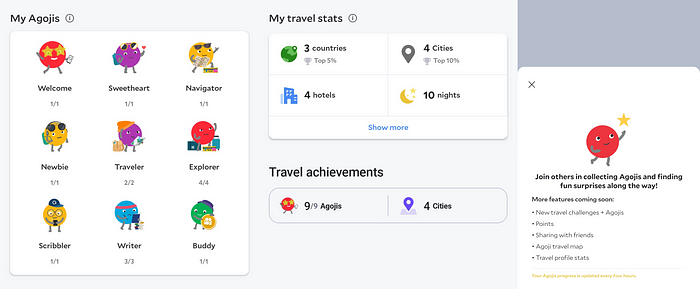

App Badges & Streak: How NOT to be dreadful at designing them
source link: https://blog.prototypr.io/app-badges-streaks-how-to-be-dreadful-at-designing-them-d104d4273338
Go to the source link to view the article. You can view the picture content, updated content and better typesetting reading experience. If the link is broken, please click the button below to view the snapshot at that time.

Grammarly — Blinkist — Headspace
App Badges & Streak: How NOT to be dreadful at designing them
App badges need not be a hit or a miss
App badges and streak are not new innovative design solutions the world hasn’t seen before. They are so old and over-used at times that the concept has become stale. The execution is somewhat debatable and always looks like it was done by a bunch of growth team members who couldn’t convince the stakeholders to make it a full-fledged feature. I will be discussing the execution of badges and streaks in ginormous products like Grammarly, Blinkist, Headspace, and Agoda.
The Case of Grammarly
Grammarly is a superb product that a lot of people I know rely on for basic grammar checks and treat it like a second set of eyes checking their content for small missable issues. To keep people motivated and create a recurring usage cycle, Grammarly implemented a usage streak that allows them to send weekly emails to their user base regarding their usage pattern. I have written in detail about streak within Grammarly here 👇.
Issue #1 — Accessibility
is useful both on mobile as well as on desktop devices and for the company to make badges and streaks relevant to the users it needs to make the feature more accessible. Without accessibility streaks or badges don’t hold much relevancy to the user. In the case of Grammarly, the user experience is quite bad. The user has to rely on some email to track their past data and the so-called “badges” that they collected for a long duration are only accessible if they can find the latest email that was sent to their email inboxes.
The latest company to have a similar badge delivery service as Grammarly is
. Blinkist has quite recently integrated badges based on usage parameters but the company prefers to send them over email. As we all know, emails are not the best place to send ‘brag-able’ information like points, streaks, and badges because of the lack of accessibility that users might face. As a company you want people to be proud of these badges and the streak that they have achieved. This means that they should be stored somewhere on your mobile app so that the user can show them to their friends or office colleagues to brag about them.
In the case of Blinkist and Grammarly, both fail at making their social data accessible to their audience on their preferred form factor and at their fingertips. Since the feature is poorly executed, it can easily give the impression that it was not built with heart and probably didn't get the blessings that were required.
The Case of Headspace
Headspace is one of those apps that have skyrocketed and made a name for itself in the meditation and mental health space. That is because of its soulful audio artists’, relevant content, and delightful animations. With that said, things like word-of-mouth, sticky marketing, and the need for fixing mental health issues is also contributing factor to its success. The app also has a streak as a way for rewards its customers. You can read more about my thoughts on a streak on another blog that a wrote 👇.
Headspace has streaks and it wants to connect people’s self-esteem to the data. To drive usage, after every meditation session, the user is shown their latest streak number. Although the app’s latest version offers users the flexibility to hide 🙈 their streak data on the accounts page, the company has unfortunately missed the relevancy of meditation and its connection to streak.
Issue #2 — Product Relevancy
Although streak can be a valuable tool in a product’s arsenal, when used incorrectly it can look like it was not well thought out. In the case of Headspace, unfortunately, streak data harms the user’s mental health state more than it helps them after a point. You see, when a person is just starting with meditation then they usually require tools like notifications and streak to make sure they open the app and practice meditation. But as the user increases the days they practice meditation, they slowly realize that they don’t need an external voice or force to continue with it. It becomes a habit and after 30–60 days of continuous practice, I felt like I don’t even need to reach out to the app. I could easily enter a meditation state or be still without even needing an app to tell me to do so.
Intentional implementation — Agoda
You might have not heard of the app — Agoda. The travel & leisure app is most famous in the South East Asian region and is a part of Booking Holdings Inc. As with all travel apps, the user can book flights, hotels, or even fun activities on its mobile app. Coincidently, Agoda also introduced streak & badges into its ecosystem and it was called “Agoji”. They used a set of fun character designs that look like colorful blobs that are ready for their next travel adventure.

Agojis in Agoda-app
Their solution hit all the right notes —
- The visual appeal/mascot direction is fun and emoji-fied
- The app reflects updates every 4 hours
- The app doesn’t disturb me with non-sensical data on my email
- Users have a way to monitor their progress from the app
- There is a link to the expanded progress stack from the home screen
- Badges are connected to tasks and not a streak number like the number of hotels booked. Badges are used to discover various features in the app. Travel stats are also located in the same area but it appears as a moving number rather than something that is designed to force users to make more bookings
Although like any other app out there, Agoda wants its, users, to use its services more often. But rather than connecting the bookings data to streak & badges, they focused on motivating users to learn various features of the app, which can make using the app easier in the future.
Nitpick: It’s not mapped out for the long haul. There are just nine Agojis that a user can earn. After that, they might want more, but there is no way to get it.
Ideal Solution
Although there is no ideal solution to the badges and streak problem, there is a better way to implement the features. Here is my short but useful checklist that if followed can result in a superior user experience and make streaks & badges more useful than ever.
- Integrate progress/streak and badges in the app. Don’t rely on communicating this information via email as emails can be quite cluttered.
- Access whether streaks and badges make sense for your app. If your app motivates people to get away from their mobile phones then rewarding them for reusing your app every day might not be the best approach.
- Make badges fun & relevant. Assume that people should be proud of looking at their chest of badges that they have collected over time. The final product should make them feel good and chances are they will help your app grow organically by showing their achievements to their friends. Besides Agoda, you can also refer to Envoy for how they successfully implemented a passport stamp approach in their office check-in app.
- Make sure badges get updated based on progress made in 24hrs or less.
- Integrate badges that aid users in discovering your product's critical features. Then to make your app sticky and retain users, figure out the minimum usage metric that your users need to reach for them to be retained for long.
- Create a roadmap of badges that the users can collect over a long time but not too long. Grammarly has a badge roadmap for 280 weeks. It might be a bit too long for users to reach that life span of product usage but to me, it also looks like it is a stretched goal that the company is projecting. The mapped-out roadmap should be long enough to make them feel excited and valued. Any more than that will bore them out.
Streaks & badges are both gamification mechanisms meant to motivate users to outperform others, enjoy the services offered by the company and eventually become recurring users of the app. But like any game mechanics, if we don’t design the triggers and intrinsic motivators correctly then the product feature eventually becomes unusable for its users.
Recommend
About Joyk
Aggregate valuable and interesting links.
Joyk means Joy of geeK